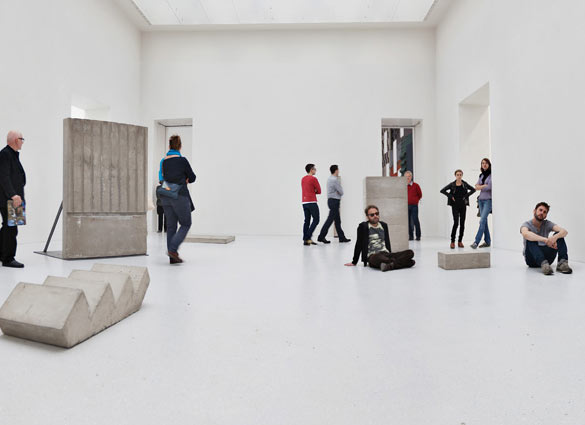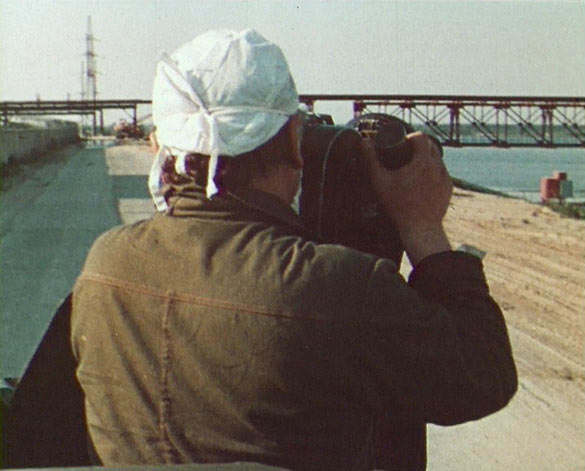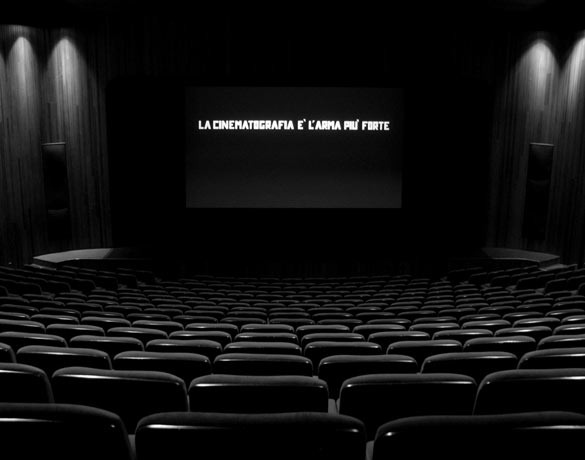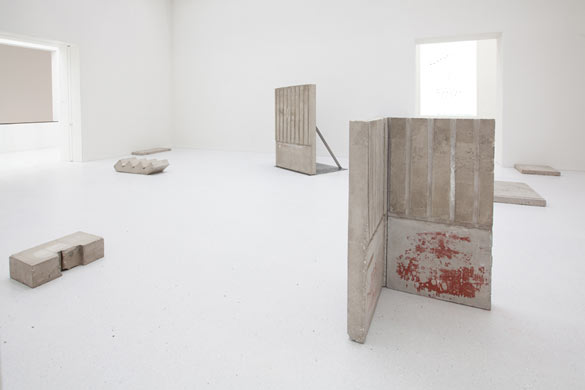Rossella Biscotti, History Repeating

Ont émergé ces dernières années nombre d’artistes se positionnant comme les relais d’une Histoire « officieuse » qui se serait construite en marge du récit officiel, offrant ainsi un nouveau point de vue sur des évènements passés sous silence ou désormais oubliés [1]. De Mathieu K. Abonnenc à Ruth Ewan, en passant par Jeremiah Day ou Francesco Arena, tous s’emparent de ces moments qui ont échappé à l’Histoire, ces mouvements ésotériques ou politiques restés dans l’ombre des idéologies dominantes, pour tenter d’écrire une autre Histoire du XXe siècle. Sans chercher à les réunir sous une appellation générique et forcément réductrice – archéologie contemporaine ? Anthropologie du quotidien ? –, on ne peut que constater les nombreux liens entre leurs différentes démarches.
Rossella Biscotti s’inscrit, à n’en pas douter, dans cette mouvance. Le travail de cette jeune artiste italienne s’articule en effet autour d’une réflexion sur la mémoire – fictive, refoulée, fantasmée – et la reconstruction des choses passées. En se concentrant sur la reconstitution d’évènements où des points de vue collectif et individuel se confrontent, elle cherche à « remplir » les blancs de l’Histoire, s’intéressant notamment à ceux qu’on pourrait qualifier d’« anonymes de l’Histoire », dont elle tente de retracer le parcours. Selon elle, il est impossible de reconstituer la biographie d’un individu en la séparant de son contexte, d’où cette volonté affirmée de mêler grande Histoire et histoire personnelle. Pour ce faire, l’artiste procède suivant le même modus operandi : recherche/investigation, écriture d’un script, montage et editing. Toutefois, loin de chercher LA vérité unique, immuable, l’artiste s’attelle plutôt à reconstituer une vérité, subjective, parfois parcellaire, considérant que « la vérité n’existe pas, tout comme il n’existe pas une seule version de l’histoire [2] ». Elle s’interroge ainsi sur la perte d’informations inhérente à ce type de démarche, l’ambigüité de la reconstruction et les utilisations possibles des sources qu’elle s’approprie. Rossella Biscotti ne se situe toutefois pas dans la « simple » reconstitution de faits historiques. Les éléments qu’elle manipule sont une étape inaugurale, lui permettant d’entamer ensuite l’écriture d’un nouveau récit, de s’interroger sur la manière dont nous percevons aujourd’hui ces évènements passés, quel impact ils ont eu sur notre vie et quel écho ils ont encore aujourd’hui. De fait, elle ne s’intéresse pas à l’actualité la plus récente, mais privilégie une lecture des évènements a posteriori, distanciée et plus documentée : « Je suis intéressée par les traces de l’histoire : documents, films, photographies. Ils offrent une autre vision de la réalité. Ce n’est que lorsque ces images sont interprétées, décodées et partagées avec d’autres qu’elles prennent un nouveau sens. Mon travail explore l’écart entre l’histoire et son interprétation, entre l’expérience et son archive [3] ».

Rossella Biscotti, The Sun Shines in Kiev, 2006. Video still, DVD, 18’; Editing: Toon de Zoeten, music: FRAME (Leandro Sorrentino e Davide Mastropaolo); Courtesy Wilfried Lentz Rotterdam.
Le projet The Sun Shines in Kiev (2006) est emblématique de cette démarche. Composée d’un film, de trois slideshows et d’un poster cette installation revient sur la vie de Vladimir Shevchenko, réalisateur ukrainien qui fut l’un des premiers à accéder à la « red zone » après l’accident nucléaire de Tchernobyl en 1986. L’artiste nous donne ici à voir les images filmées à l’époque par Shevchenko, précieux document qui témoigne de l’ampleur de la catastrophe – de nombreux points blancs, tels des flashs, apparaissent à l’écran, traces tangibles de la radiation invisible qui attaque et altère la surface de la pellicule – tout en interrogeant notre rapport à ces images et à leur prétendue véracité. En effet, presque trente ans après ce drame, il nous est toujours impossible de savoir ce qui est réellement arrivé à Tchernobyl, la version officielle ayant varié au gré des intérêts des différents gouvernements. Aucune possibilité d’avoir une appréhension globale de cet événement, simplement une vision parcellaire, fragmentée, parfois contradictoire. C’est justement cela qui intéresse Rossella Biscotti, la manière dont la fiction peut parvenir à modifier notre perception d’un événement. Pour T.J. Demos, « que son travail n’offre pas de significations transparentes la connecte à la pratique émergente d’une historiographie contemporaine expérimentale, fondée sur la théorie poststructuraliste, qui rejette l’histoire définitive et véridique, au profit d’avis subjectifs [4] ».
C’est cette même méthode de travail que l’artiste applique à des évènements récents de l’histoire politique italienne. Aujourd’hui basée à Bruxelles, l’artiste n’en demeure pas moins extrêmement attachée à ses origines italiennes. Ainsi de sa pièce La cinematografia e’ l’arma piu’ forte [5] (2004-2007), slogan tiré d’une bannière installée par Mussolini au moment de l’inauguration de Cinecittà en 1937 et diffusé, à la demande de Rossella Biscotti, dans plusieurs cinémas italiens en préambule du film programmé. Un geste éminemment politique, puisque l’artiste y établissait clairement un parallèle entre Mussolini et le gouvernement de Berlusconi, en soulignant les dérives possibles de l’intrusion du politique et de l’économique dans le champ culturel. Avec Il Processo (The Trial) (2010-2011), présenté lors de dOCUMENTA (13), l’artiste revenait sur les années de plomb, et plus spécifiquement sur le procès « 7 avril », lors duquel plusieurs membres du mouvement Autonomia Operaia – dont Antonio Negri et Paolo Virno – furent jugés, accusés d’être moralement et idéologiquement responsables des actes terroristes menés en Italie à la fin des années 1970, dont l’enlèvement et l’assassinat d’Aldo Moro. L’installation, composée d’un montage des enregistrements et de leur traduction « live », revenait sur ce moment important de l’histoire italienne tout en soulignant les liens qui existent entre mémoire, langage, image et architecture, par le biais d’un ensemble de sculptures réalisées à partir de moulages de l’Aula Bunker, le tribunal de haute sécurité de Rome où eut lieu ce procès.

Rossella Biscotti, La cinematografia e’ l’arma piu’ forte (The cinematography is the strongest weapon), 2007. Diaporama, Slidepiece. Site-specific intervention, cinema du / of the Cultuurcentrum Strombeek, (BE).
Le corpus développé depuis quelques années par Rossella Biscotti fait également écho au travail de Fabio Mauri, compagnon de route de Pier Paolo Pasolini et figure incontournable de la scène artistique italienne, qui s’attelait à dévoiler le sens caché des images, à montrer leur poids et la dictature qu’elles imposaient sur la lecture du réel [6]. C’est cette entreprise de dissection et d’analyse que poursuit désormais la jeune artiste italienne, en s’attachant à modifier nos habitudes de spectateur : « Je pense qu’arriver aujourd’hui avec un système différent pour raconter les histoires que tout le monde connaît est la manière la plus efficace afin qu’elles atteignent leur destination [7] ». Ou comment assembler des éléments disparates pour élaborer un nouveau récit et proposer un point de vue décalé, « désaxé », sur un moment oublié de la marche du monde.
- ↑ Voir à ce sujet le texte de Marc Godfrey, « The Artist as Historian », in October n°120, printemps 2007, p. 140-172.
- ↑ Rossella Biscotti, in Roberta Tenconi, « Introducing: RB », Mousse n° 20, septembre-octobre 2009, p. 136.
- ↑ Rossella Biscotti, in Barbara Casavecchia, « Back to the future #26 », Klat n°4, automne 2010.
- ↑ T.J. Demos, « A Form of “Total Revolution”: The Art of Rossella Biscotti », in Rossella Biscotti, Rome : MAXXI – Museo Nazionale delle Arti del XXI Secolo, 2012, p. 11-15.
- ↑ « Le cinéma est l’arme la plus puissante », en français.
- ↑ Voir notamment les livres Linguaggio è guerra, Rome, Marani, 1975 et Manipolazione di cultura, Pollenza, La Nuova Foglio, 1976.
- ↑ Rossella Biscotti, in Barbara Casavecchia, « Back to the future #26 », Klat n°4, automne 2010.
Rossella Biscotti, History Repeating
In the past few years quite a lot of artists have emerged as intermediaries of an “unofficial” History that has been constructed on the sidelines of the official narrative, thus offering a new viewpoint on events that have either been greeted with silence, or are now forgotten [1]. From Mathieu K. Abonnenc to Ruth Ewan, by way of Jeremiah Day and Francesco Arena, all of them appropriate those moments which have dodged History, those esoteric and political movements which have remained in the shadow of the predominant ideologies, to attempt to write another history of the 20th century. Without trying to bring them all together under some overall and perforce simplistic term—contemporary archaeology? anthropology of the day-to-day?—it is impossible not to note the many links between their different approaches.
Rossella Biscotti is undoubtedly part and parcel of this movement. The work of this young Italian artist is organized around a line of thinking about memory—fictitious, repressed, fantasized—and about the reconstruction of things past. By focusing on the re-creation of events where collective and individual viewpoints confront one another, she tries to “fill in” the blanks of History, with a particular interest in the ones that we might describe as the “anonymous ones of History”, whose itinerary she attempts to trace. According to her, it is impossible to re-create the biography of a person by separating him or her from their context, whence this assertive desire to mix grand History and personal history. To do this, the artist proceeds by adopting the same modus operandi: research/ investigation, writing a script, montage and editing. However, far from seeking out THE sole and immutable truth, the artist grapples rather with re-creating a subjective and at times fragmented truth, reckoning that “the truth does not exist, just as a single version of the story does not exist [2] ”. She thus questions the loss of information inherent in this kind of approach, the ambiguity of reconstruction, and the possible uses of the sources she appropriates. Rossella Biscotti does not, however, situate herself in the “mere” re-creation of historical facts. The elements she manipulates are an initial stage enabling her to then embark on the writing of a new narrative, and question the way we nowadays perceive those past events, the impact they have had on our lives, and the echo which they still have today. She is actually not interested in the latest news, preferring an after-the-fact reading of events which is removed and more documented. “I’m interested in the traces of history: documents, films, photographs. They offer another vision of reality. Only when these images are interpreted, decoded and shared publicly with others do they develop new meanings. My works explore the gap between history and its interpretation, between experience and its archiving [3] ”.

Rossella Biscotti, Il Processo (The Trial), 2010-2012. Installation sonore en boucle de 6 h, éléments coulés en béton armé / Audio installation, 6 hours in loop, casted pieces in reinforced concrete. Vue d’exposition / Installation view dOCUMENTA (13), Kassel; Courtesy Rossella Biscotti; Photo : Ela Bialkowska, Okno studio.
The project The Sun Shines in Kiev (2006) is emblematic of this approach. Made up of a film, three slide shows and a poster, this installation goes back over the life of Vladimir Shevchenko, a Ukrainian film director who was one of the first to gain access to the “red zone” after the nuclear accident at Chernobyl in 1986. The artist here presents us with the images filmed at the time by Shevchenko, a valuable document which illustrates the breadth and scale of the catastrophe—lots of white dots, like flashes, appear on the screen, tangible traces of the invisible radiation that attacks and alters the film’s surface—while at the same time questioning our relation to these images and their claimed truthfulness. In fact, almost thirty years after that drama, we still have no way of knowing what really came to pass at Chernobyl, because the official version has varied depending on the interests of successive different governments. There is no possibility of gaining an overall understanding of that event, just a fragmented and at times contradictory part-vision. This is precisely what interested Rossella Biscotti, the way in which fiction can successfully alter our perception of an event. For T. J. Demos, the fact that “her work doesn’t offer transparent meanings also connects it to the emergent practice of a contemporary experimental historiography, one founded in poststructuralist theory, that rejects truthful and definitive history, in favor of subjective accounts [4] ”. It is this same working method that the artist applies to recent events in Italian political history. Brussels-based today, she remains extremely attached to her Italian origins. Whence her piece La cinematografia è l’arma più forte [5] (2004-2007), a slogan taken from a banner raised by Mussolini at the inauguration of Cinecittà in 1937, and broadcast, at Rossella Biscotti’s request, in several Italian cinemas as a preamble to the scheduled film. An eminently political gesture, because in it the artist clearly established a parallel between Mussolini and the Berlusconi government, by underscoring the possible aberrations of the intrusion of politics and economics in the cultural arena. With Il Processo (The Trial) (2010-2011), which was presented at dOCUMENTA (13), the artist returned to the “years of lead”—the period of turmoil from the 1960s to the 1980s in Italy—and more specifically to the “7th of April” trial (7 April 1979), at which several members of the movement Autonomia Operaia—including Antonio Negri and Paolo Virno—were found guilty, accused of being morally and ideologically responsible for terrorist acts conducted in Italy in the late 1970s, including the kidnapping and assassination of Aldo Moro. The installation, consisting of a montage of recordings and their live translation, went back to that significant moment in Italian history while at the same time underscoring the links that exist between memory, language, image and architecture, by way of a set of sculptures made from casts of the Aula Bunker, the top security court house in Rome where the trial was held.
The body of work developed over the past few years by Rossella Biscotti also echoes the work of Fabio Mauri, Pier Paolo Pasolini’s travelling companion, and a seminal figure in the Italian art scene, who focused on revealing the hidden meaning of things, and showing the dictatorial influence they had on the way people read reality [6]. It is this endeavour of dissection and analysis that the young Italian artist is now pursuing, by striving to alter our spectator habits: “ I think that coming up today with a different system for telling stories that everyone knows is the most effective way of making sure they reach their destination [7] ”. Or how to assemble disparate elements to work out a new narrative and come up with an offbeat, “unbalanced” viewpoint on a forgotten moment of the way the world turns.
- ↑ See on this subject the text by Marc Godfrey, “The Artist as Historian”, in October n°120, Spring 2007, p. 140-172.
- ↑ Rossella Biscotti, in Roberta Tenconi, “Introducing: RB”, Mousse n° 20, September-October 2009, p. 136.
- ↑ Rossella Biscotti, in Barbara Casavecchia, “Back to the future #26”, Klat n°4, Autumn 2010.
- ↑ T. J. Demos, “A Form of ‘Total Revolution’: The Art of Rossella Biscotti”, in Rossella Biscotti, Rome, MAXXI – Museo Nazionale delle Arti del XXI Secolo, 2012, p. 11-15.
- ↑ “Cinema is the most powerful weapon”.
- ↑ See in particular the books Linguaggio è guerra, Rome, Marani, 1975 and Manipolazione di cultura, Pollenza, La Nuova Foglio, 1976.
- ↑ Rossella Biscotti, in Barbara Casavecchia, “Back to the future #26”, Klat n°4, Autumn 2010.
- Partage : ,
- Du même auteur : Leonor Antunes, Laëtitia Badaut Haussmann, Walid Raad, Inside Information, Sterling Ruby, Rosa Barba : Universal Cinema,
articles liés
Iván Argote
par Patrice Joly
Laurent Proux
par Guillaume Lasserre
Diego Bianchi
par Vanessa Morisset

